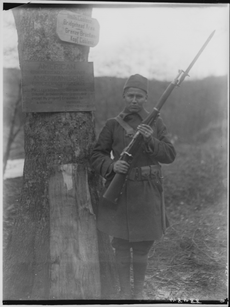احتلال أرض الراين
50°22′N 7°36′E / 50.367°N 7.600°E
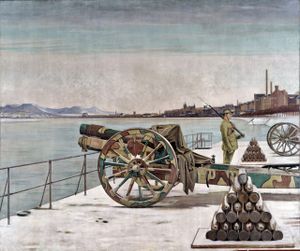 المراقبة على الراين، (الطور الأخير) بريشة وليام روتنشتاين | |
| التاريخ | 1 ديسمبر 1918 – 30 يونيو 1930 |
|---|---|
| الزمن المستغرق | 11 years, 6 months, 4 weeks and 1 days |
احتلال أرض الراين من 1 ديسمبر 1918 حتى 30 يونيو 1930 نتيجة انهيار الجيش الألماني الامبراطوري في 1918. بالرغم من انتصار ألمانيا على الجبهة الشرقية عقب الثورة الروسية، فإن القيادة العليا العسكرية فشلت في منع التآكل المتواصل للروح المعنوية، في الداخل وفي الجيش. وبالرغم من نقل القوات ذات الخبرة من الجبهة الشرقية للقتال على الجبهة الغربية، فإن هجوم الربيع مُنِيَ بالفشل وإثر اندلاع الثورة الألمانية اضطرت حكومة ألمانيا المؤقتة لقبول بنود هدنة 1918. وقد ضمت تلك البنود قبول احتلال قوات القوى المنتصرة الضفة اليسرى للراين وأربع "رؤوس جسور" على الضفة اليمنى بقطر 30 كيلومتر حول كولونيا، كوبلنتس و ماينز وقطر 10 كم حول كـِل. وبالإضافة لذلك، فإن الضفة اليسرى للراين وقطاع بعرض 50 كيلومتر شرق الراين أُعلِن منطقة منزوعة السلاح. معاهدة ڤرساي كررت تلك الشروط، إلا أنها حدت تواجد القوات الأجنبية لخمسة عشر عاماً بعد توقيع المعاهدة (أي حتى 1934). الغرض من الاحتلال كان من ناحية إعطاء فرنسا الأمن من هجوم ألماني مجدد، ومن الناحية الأخرى أن تعمل كضمان لسداد التعويضات. بعد تحقق ذلك بوضوح من خلال خطة ينگ، فإن احتلال أرض الراين أُنهـِيَ قبل موعده المتفق عليه، وكان الإنهاء في 30 يونيو 1930. ادارة أرض الراين المحتلة كان من اختصاص مفوضية الحلفاء المشتركة العليا لأرض الراين ومقرها في المجلس الرئاسي الأعلى لمقاطعة الراين في كوبلنتس.
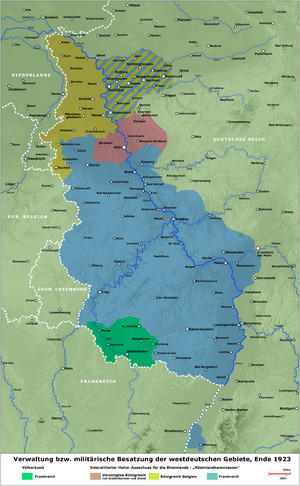
— الأزرق: فرنسا
— الأصفر: بلجيكا
— البني: المملكة المتحدة
— المقلّمة : الرور، الذي احتلته فرنسا وبلجيكا
— الأخضر: سار، التي احتلتها فرنسيا تحت رعاية عصبة الأمم[1] واصلت القوات الفرنسية احتلال أراضي ألمانية في أرض الراين حتى نهاية 1930، بينما واصلت فرنسا السيطرة على منطقة أرض السار حتى 1935.[2]
الفترات
- الهدنة الأولى (11 نوفمبر 1918 – 13 ديسمبر 1918)
- التمديد الأول للهدنة (13 ديسمبر 1918 – 16 يناير 1919)
- التمديد الثاني للهدنة (16 يناير 1919 – 16 فبراير 1919)
- التمديد الثالث للهدنة (16 فبراير 1919 – 10 يناير 1920)
- 1920: تأسيس مفوضية الحلفاء المشتركة العليا لأرض الراين (10 يناير 1920، الفقرات 428–431 في معاهدة ڤرساي)
- 1930: حسب بنود معاهدات لوكارنو 1925–26، انسحبت قوات الحلفاء.[3]
- 1936: إعادة عسكرة أرض الراين بالقوات الألمانية في عهد هتلر، في 7 مارس.[3]
قوات الاحتلال
القوات البلجيكية
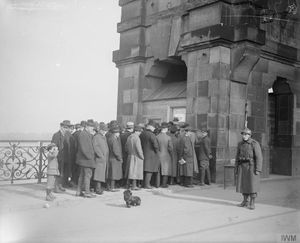
This consisted of 20,000 soldiers[بحاجة لمصدر] (five divisions)[4] with its headquarters at Aachen, and with its troops stationed in Krefeld.[5] They were commanded by Armand Huyghé.
جيش الراين البريطاني
The British Army entered German territory on 3 December 1918.[6] The British Army of the Rhine was established as the occupying force in March 1919. Based at Cologne, they published The Cologne Post.
جيش الراين الفرنسي
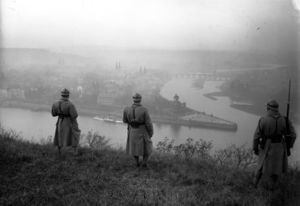
The French Eighth and Tenth armies originally constituted the French forces involved in the occupation. The Eighth Army was commanded by General Augustin Gérard and occupied the Palatinate. The Tenth Army was commanded by General Charles Mangin and was responsible for the rest of the French zone from its headquarters in Mainz.
On 21 October 1919, they were combined to form the French Army of the Rhine.
In 1919 France stationed between 25,000 and 40,000 French colonial soldiers in the Rhineland.[7] Some German women married African soldiers from the occupying forces, while others had children by them out of wedlock (hence the disparaging label "Rhineland Bastards")[8] and were considered by right-wing Germans to constitute a public disgrace.[9] General Henry Tureman Allen reported to the US Secretary of State that from the start of the occupation until June 1920 there were 66 cases of formal accusations against colored colonial troops, out of which there were 28 convictions, and admits there were many more unreported cases.[10] Despite these occasional cases, "the wholesale atrocities by French negro Colonial troops alleged in the German press, such as the alleged abductions, followed by rape, mutilation, murder and concealment of the bodies of the victims are false and intended as political propaganda".[11]
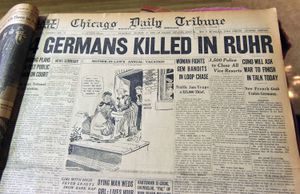
French occupation of Frankfurt occurred from 6 April to 17 May 1920. On the second day nine civilians were shot by Moroccan troops in an incident outside the Hauptwache. This incident was used to launch a racist campaign against the French use of colonial troops, linking the incident with allegations of wide spread assaults by Black soldiers in the French occupation army on local women[10] including accusations of systemic rape and other atrocities targeting the German civilian population and attributed mainly to Senegalese Tirailleurs.[12] The events resulted in a widespread campaign by the German right-wing press, which dubbed them as "The Black Shame" (Die schwarze Schande or Die schwarze Schmach) and depicted them as a form of French humiliation of the German nation.[13]
In 1923, in response to German failure to pay reparations under the Treaty of Versailles, France and Belgium occupied the industrial Ruhr area of Germany, most of which lies across the river on the east bank of the Rhine, until 1925. Many Germans were killed during civil disobedience protests. e.g. against dismissal of German officials.[14][15]
القوات الأمريكية في ألمانيا (1919–1923)
The الولايات المتحدة originally provided around 240,000 men in nine veteran divisions, nearly a third of the total occupying force. General John J. Pershing, commander of the American Expeditionary Force (A. E. F.) on the Western Front, established Third Army for the purpose, under the command of Major General Joseph T. Dickman.[16] Third Army was assigned to occupy the northern sector of the Coblenz bridgehead. By July 1919, Third Army was disbanded, having been reduced to about 8,400 men, and was renamed American Forces in Germany (AF in G). AF in G withdrew on 24 January 1923, vacating Ehrenbreitstein, which was promptly occupied by the French.
قوات التجريدة السيامية
شاركت قوات التجريدة السيامية، هي الأخرى، في الاحتلال حتى 1919 بقواتها التي تمركزت في Neustadt an der Weinstraße، الواقعة في المنطقة الفرنسية.
انظر أيضاً
المراجع
- ^ Edmonds, (1943), p. 1
- ^ Emmanuel Pénicaut. "L'armée française en Sarre, 1918-1930" (in الفرنسية)., Revue historique des armées, Service historique de la défense.
- ^ أ ب Mortimer, Louis R. (August 1995). "Detailed Analytical Study of Germany; Inclusiveness on, occupation of Rhineland" (PDF) (PDF).
{{cite web}}: Check|archive-url=value (help) - ^ Pawley (2008) p. 39
- ^ Pawley (2008) p. 41
- ^ Philip Gibbs on the Allied Occupation of the Rhineland, December 1918 accessed 11 September 2010
- ^ Wigger (2010) p. 35
- ^ Tina Campt, Other Germans: Black Germans and the Politics of Race, Gender, and Memory in the Third Reich (University of Michigan Press, 2004), p. 50 ff.
- ^ Julia Roos, "Women's Rights, Nationalist Anxiety, and the 'Moral' Agenda in the Early Weimar Republic: Revisiting the 'Black Horror' Campaign against France's African Occupation Troops". Central European History, 42 (September 2009), 473–508.
- ^ أ ب "Finds Negro troops orderly on Rhine" (PDF). The New York Times. 20 February 1921.
Undoubtedly many cases have occurred where many girls or women have been assaulted by of the French colored Colonial troops...cases which were not included in official figures...natural desire to keep out...
- ^ "FINDS NEGRO TROOPS ORDERLY ON RHINE; General Allen Reports Charges Are German Propaganda, 'Especially for America'", The New York Times, 20 February 1921
- ^ LES TIRAILLEURS SENEGALAIS ET L’ANTHROPOLOGIE COLONIALE UN LITIGE FRANCO-ALLEMAND AUX LENDEMAINS DE LA PREMIERE GUERRE MONDIALE, Hans-Jürgen Lüsebrink
- ^ La « Honte Noire ». Racisme et propagande allemande après la Première Guerre mondiale, Estelle Fohr-Prigent
- ^ "Anaconda Standard". 1923-02-10.
Twenty Germans were said to have been killed and several French soldiers wounded when a mob at Rapoch attempted to prevent the expulsion of one hundred officials. Picture shows French guard being doubled outside the station at Bochum following a collision between German mob and the French
- ^ "Hanover Evening Sun". 1923-03-15.
Three Germans killed in Ruhr by French sentries
- ^ Pawley (2008) pp. 32–33
ببليوگرافيا
- Edmonds, J.E. (1987) [1943]. The Occupation of the Rhineland 1918–29. HMSO. ISBN 978-0-11-290454-0.
- Pawley, Margaret (2008). The Watch on the Rhine: The Military Occupation of the Rhineland, 1918–1930. I.B.Tauris. ISBN 978-1-84511-457-2.
- Wigger, Iris (2010). "'Black Shame' – the campaign against 'racial degeneration' and female degradation in interwar Europe". Race and Class. Institute of Race Relations. 51 (3). ISBN 978-1-84787-414-6. ISSN 0306-3968.
وصلات خارجية
- The French Occupation of the Rhineland, 1918–1930
- Map of Europe during the Occupation of the Rhineland at omniatlas.com
- Pages using gadget WikiMiniAtlas
- CS1 الفرنسية-language sources (fr)
- CS1 errors: URL
- CS1: Julian–Gregorian uncertainty
- Coordinates on Wikidata
- مقالات ذات عبارات بحاجة لمصادر
- Articles with hatnote templates targeting a nonexistent page
- Pages using Sister project links with wikidata mismatch
- Pages using Sister project links with hidden wikidata
- احتلال أرض الراين
- 20th century in international relations
- تبعات الحرب العالمية الأولى
- American military occupations
- Belgian military occupations
- British military occupations
- Foreign relations of the Weimar Republic
- French military occupations
- تاريخ أرض الراين
- فترة ما بين الحربين
- التاريخ العسكري لألمانيا
